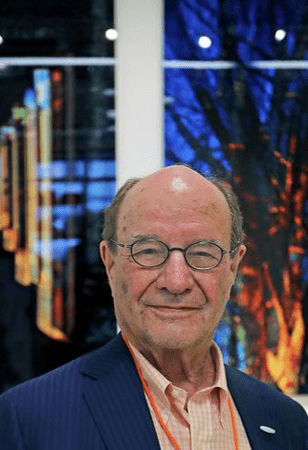Featured content
An interview by iBiology with Wally Gilbert.
About Wally

Artist, scientist, Nobel Laureate
Walter Gilbert, born March 21, 1932, to an economist, then teaching at Harvard University, and a child psychologist, majored in Chemistry and Physics at Harvard, B. Sc. Summa Cum Laude in 1953, and went on to graduate work in Theoretical Physics at Cambridge University, working in the Quantum Theory of Fields with Abdus Salam (1979 Nobel Prize), Ph. D. in Mathematics in 1957. Returning to Harvard, after a year as a postdoctoral fellow he became the assistant to Julian Schwinger (1965 Nobel Prize) and then, in 1959, an Assistant Professor in the Physics Department, teaching a range of courses in Theoretical Physics including Quantum Mechanics and Relativity.
The molecular biologist James Watson (1962 Nobel Prize) invited Gilbert to join him in the search to identify messenger RNA (mRNA), an unstable nucleic acid that carries the information to specify a protein from the DNA to the ribosome where the protein is made. Gilbert became fascinated with laboratory Biology, working then on protein synthesis and on the control of genes by repressors. Harvard tenured him in 1964 in Biophysics, in1968, a Professor of Biochemistry and in 1972, an American Cancer Society Professor of Molecular Biology.
Gilbert was awarded the 1980 Nobel Prize for Chemistry together with the biochemists Frederick Sanger (GB) and Paul Berg (USA). The prize recognized the field of Recombinant DNA, to Berg for the technology of moving genes into new organisms, and to Gilbert and Sanger for the ability to completely decipher those genes. Gilbert and Sanger developed, independently of one another, rapid methods for determining the exact sequence of the chemical groups, the bases, in DNA. Both methods determined the position of a base by measuring its distance from a specific point, by making a DNA fragment whose length ran out to the base of interest. Sanger’s method made such fragments enzymatically; Gilbert’s method made them by base-specific chemical cleavage. Both methods could read hundreds of bases in a single afternoon, where before a single base might take a month. By the time of the prize in 1980, about a million bases of DNA had been sequenced around the world. The 3 billion bases of the human Genome were worked out by 2000. The development of ever more rapid sequencing has now led to thousands of genomes of all species being understood, and the detailed evolution of our species, and the modifications of our cells in disease becoming known.
In 1978, Gilbert and Phillip Sharp (1993 Nobel Prize) and a group of European Scientists founded the biotechnology company Biogen, of which Gilbert became CEO. In 1981. Gilbert returned to Harvard in 1985 and worked on the early evolution of genes until he retired in 2001.
Gilbert co-founded Myriad Genetics, which identified the genes involved in hereditary breast cancer, and is still a director. He is on the board of Amylyx Pharmaceuticals, which is doing clinical trials in ALS.
Since 2002, Gilbert has been doing digital art and has had many one-person shows: http://wallygilbert.com.
Residing in Cambridge, MA, he is married to Celia Gilbert, a poet and artist, and has two children and four grandchildren.

